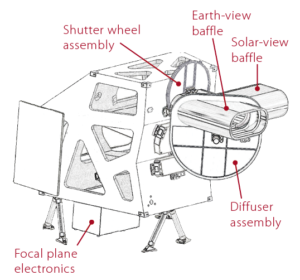
The OLI-2 is a pushbroom sensor. So its focal plane has a long arrays of photosensitive detectors Incident radiation is focused onto the focal plane by a four-mirror anastigmatic telescope. OLI-2 has a 15-degree field-of-view covering a 185 km (115 mi) across-track ground swath. Landsat 9’s photosensitive detectors are divided into 14 modules. There are ~7000 across-track detectors for each OLI-2 spectral band, except the 15-m (49 ft) panchromatic band that has 13,000 detectors.
Each spectral band has a specific filter; together the filters are arranged like a “butcher-block” over each module’s detector array. The visible and near-infrared detectors are made from Silicon PIN (SiPIN). The shortwave infrared detectors are made from Mercury–Cadmium–Telluride (HgCdTe).
The OLI-2 telescope views the Earth through its Earth-view baffle. There is a shutter wheel assembly between the Earth-view baffle and the aperture stop. Light enters the telescope via a hole in the shutter wheel during nominal observations. The solar-view baffle is occasionally pointed at the sun so that a diffuser panel can reflect solar illumination into the telescope for calibration purposes.
Two lamp assemblies, with six small lamps each, inside an integrating hemisphere can illuminate the full OLI-2 focal plane through the telescope with the shutter closed as another component of the OLI-2 calibration subsystem.

Related Stories from Landsat 9’s Development:
May 23, 2018: In Focus: A Peak at Landsat 9’s OLI-2 Instrument During Focal Plane Integration
Sept. 29, 2017: Landsat 9’s OLI-2 Instrument Takes Shape

